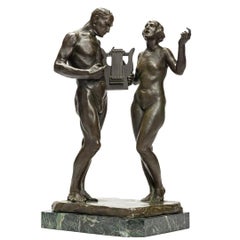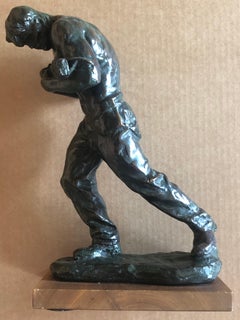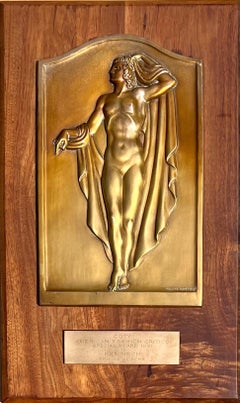Max Kalish Art
American, Lithuanian, 1891-1945
Born in Poland March 1, 1891, figurative sculptor Max Kalish came to the United States in 1894, his family settling in Ohio. A talented youth, Kalish enrolled at the Cleveland Institute of Art as a fifteen-year-old, receiving a first-place award for modeling the figure during studies with Herman Matzen. Kalish went to New York City following graduation, studying with Isidore Konti and Herbert Adams for the next two years.
In 1912, Kalish studied with Paul Bartlett at the Academie Colarossi in Paris, France. In 1913, he continued his studies with Jean Antoine Injalbert at the Ecole des Beaux-Arts. The financial support of his brother, family and friends had enabled Kalish to travel to Europe. But the money ran out and, though Kalish exhibited two portrait busts in the 1913 Paris Salon, he was forced to return to America, where he worked on the Column of Progress for the 1915 Panama-Pacific Exposition, in San Francisco, California, with his former teacher, Isidore Konti.
Back in Cleveland, he worked on portrait commissions of two United States Senators and the Mayor. In the Army by 1916, Kalish sculpted a series of bronze, one-third-life-size figures of solders. In 1920, he was back in Paris, where he would begin a life-long practice of spending half the year. In 1921, he sculpted his first laborer, “The Stoker”, a genre for which he would be best known, using as a model, a Cleveland blast furnace worker. In Paris in 1922, the sculptures of laborers by Belgian artist Constantine Meunier (1831-1905) cemented Kalish’s desire to sculpt workers. Kalish won first prize for four sculptures three laborers — in 1925 at the Cleveland Artists and Craftsmen exhibition, one of which a marble nude torso was acquired by the Cleveland Museum of Art. This prize and purchase accelerated Kalish’s career. In 1928, he received a commission from the City of Cleveland for a twelve-foot-high bronze sculpture of Abraham Lincoln delivering the Gettysburg Address. It stands today in front of the west entrance of the Board of Education on East 6th Street.
Living and working in New York City in 1932, he was elected an Associate of the National Academy of Design in 1933. He later became a member of the National Sculpture Society. At the outset of World War II, Kalish was commissioned by the Museum of American History to sculpt forty-eight bronze figures — one-third-life-size — of those involved in the war effort, including President Roosevelt, his cabinet and other important people. He lived to see the work completed, though afflicted by cancer from which he died on March 18, 1945 in New York City. The sculpture of Max Kalish was included in the 1997 exhibition in Berkeley, California, “When Artists Became Workers: The People’s Art Movement of the ’30s and ’40s”, at the Judah L. Magnes Museum.(Biography provided by WOLFS)
to
4
4
Overall Height
to
Overall Width
to
3
4
4
2
2
1
1
4
1
3
4
6,827
3,109
2,517
1,217
3
3
1
1
1
Artist: Max Kalish
Nude Walking, Early 20th Century Bronze Sculpture, Cleveland School Artist
By Max Kalish
Located in Beachwood, OH
Max Kalish (American, 1891-1945)
Nude Walking, 1930
Bronze
Signed and dated on base
17 x 9 x 4 inches
Born in Poland March 1, 1891, figurative sculptor Max Kalish came to the United...
Category
1930s American Modern Max Kalish Art
Materials
Bronze
"Road Builder" 20th Century Modern WPA Labor Bronze WPA Depression-Era Sculpture
By Max Kalish
Located in New York, NY
Max Kalish
The Road Builder
inscribed M. KALISH 23, with Meroni-Radice foundry mark, on top of base bronze with dark brown patina, on an ebonized rectangular plinth
Height: 13 1/8 in...
Category
1920s American Realist Max Kalish Art
Materials
Bronze
Harmony, 20th century bronze & green marble base, nude man and woman with lyre
By Max Kalish
Located in Beachwood, OH
Max Kalish (American, 1891-1945)
Harmony, c. 1930
Bronze with green marble base
Incised signature on right upper side of base
14 x 9 x 5 inches, excluding base
17 x 10 x 8 inches, including base
Born in Poland March 1, 1891, figurative sculptor Max Kalish came to the United States in 1894, his family settling in Ohio. A talented youth, Kalish enrolled at the Cleveland Institute of Art as a fifteen-year-old, receiving a first-place award for modeling the figure during studies with Herman Matzen. Kalish went to New York City following graduation, studying with Isidore Konti...
Category
1930s American Modern Max Kalish Art
Materials
Marble, Bronze
Barge Toiler -Mid 20th Century Modern WPA Labor Plaster Depression-Era Sculpture
By Max Kalish
Located in New York, NY
"Barge Toiler" by Max Kalish is a Mid 20th Century modern Depression-Era sculpture from his Labor series. The WPA era work is made of plaster.
Max Kalish (1891 – 1945)
Barge Toiler...
Category
1930s American Modern Max Kalish Art
Materials
Plaster
Related Items
1961 Coty Award Plaque Kenneth Hairdresser Jacqueline Onassis Bronze Fashion
Located in New York, NY
1961 Coty Award Plaque Kenneth Hairdresser Jacqueline Onassis Bronze Fashion
Bronze on wood. The wood plaque measures 12 3/4" by 20 3/4 inches. The bronze plaque itself is 13 3/4 x 8 3/4 inches and the the bronze inscription, which reads "COTY, American Fashion Critics Special Award 1961 to KENNETH of LILY DACHE...
Category
1960s American Modern Max Kalish Art
Materials
Bronze
19th Century Bronze Sculpture "The Letter"
Located in Rochester, NY
Antique bronze sculpture of male nude reading a letter or proclamation. Marble base, 19th century. Unsigned.
Category
Early 19th Century Max Kalish Art
Materials
Marble, Bronze
Olympic Runner Bronze Grand Tour Sculpture
Located in Rochester, NY
Antique bronze sculpture. The Herculaneum runner. After the antique model in the Villa of the Papyri, Herculaneum, now located in Naples Royal Museum.
Category
19th Century Max Kalish Art
Materials
Bronze
Crepis Bronze Sculpture Nude Boy Male Figure Marble Stone
By Wim van der Kant
Located in Utrecht, NL
Crepis Bronze Sculpture Nude Boy Male Figure Marble Stone
Wim van der Kant (1949, Kampen) is a selftaught artist. Next to his busy profession as a teacher at...
Category
21st Century and Contemporary Contemporary Max Kalish Art
Materials
Marble, Bronze
Free Shipping
H 17.72 in W 7.88 in
Bufo Contemporary Bronze Sculpture Nude Boy Marble Stone Male Figure
By Wim van der Kant
Located in Utrecht, NL
Bufo Contemporary Bronze Sculpture Nude Boy Marble Stone Male Figure
Wim van der Kant (1949, Kampen) is a selftaught artist. Next to his busy profession as a teacher at a high school, he intensively practises his profession as a sculptor. Only when his work would measure up to his own standards, he decided to present it to the rest of the world. In 1995, he exhibited for the first time with Morren Galleries. Van der Kant desires to sculpt young people who still stand uninhibited and curiously in life. The reason he chooses to sculpt boys is, because he is one himself, this way the subject is closer to him. The anatomy of his figures testify of perfectionism. Van der Kant's subjects show similarities with the sculptures from the Greek and Roman antiquity...
Category
21st Century and Contemporary Contemporary Max Kalish Art
Materials
Marble, Bronze
Free Shipping
H 12.21 in W 7.88 in
Gallulus Bronze Sculpture Nude Boy Male Figure Green Patina Marble Stone
By Wim van der Kant
Located in Utrecht, NL
Gallulus Bronze Sculpture Nude Boy Male Figure Green Patina Marble Stone
Wim van der Kant (1949, Kampen) is a selftaught artist. Next to his busy profess...
Category
21st Century and Contemporary Contemporary Max Kalish Art
Materials
Marble, Bronze
Free Shipping
H 16.54 in W 7.88 in
Dolce Vita B
By Pietrina Checcacci
Located in New Rochelle, NY
Pietrina Checcacci was born in Taranto, Italy. Currently, she lives in Rio de Janeiro, Brazil. Checcacci studied at the National School of Fine Arts from 1958 to 1964 and has won n...
Category
21st Century and Contemporary Contemporary Max Kalish Art
Materials
Bronze
Maternité Allongée cm 90
By Antoniucci Volti
Located in Villafranca Di Verona, IT
Numbered and limited to 8 copies
Artwork signed
Authenticity: Sold with certificate of Authenticity from the Indivision Antoniucci Volti
Invoice from the gallery
Sculpture: bronze, ...
Category
1960s Max Kalish Art
Materials
Bronze
2 Sculptures: "The Power" & "The Glory" WPA Depression WWII era mid 20th century
By Agnes Yarnall
Located in New York, NY
2 Sculptures: "The Power" & "The Glory" WPA Depression WWII era mid 20th century by Agnes Yarnall circa 1940s.
Sculptor, painter, poet and artistic historian, Agnes Yarnall has, since the age of six been breathing life into her art.
Renowned as a sculptor, whose commissioned portrayals of contemporary celebrities are prized. She has sculpted Judith Anderson, Edna St. Vincent Millay, Carl Sandburg...
Category
1940s American Modern Max Kalish Art
Materials
Plaster
Industrial Machine Age American Scene WPA Mid 20th Century 1939 SF World's Fair
Located in New York, NY
Industrial Machine Age American Scene WPA Mid 20th Century 1939 SF World's Fair
HAIG PATIGIAN (American/Armenian, 1876-1950)
Aeronautics Pediments
Two Plaster Casts, c. 1930s
each 13.25 x 14.75 x 6 inches
It's possible these moquettes were created for the 1939 World's Fair, the Golden Gate International Exhibition in San Francisco.
Provenance: Private Collection of Lois M. Wright, Author of "A Catalogue of the Life Works of Haig Patigian, San Francisco Sculptor, 1876-1950),” 1967
Loan to Oakland Museum of California (Oakland, CA)
BIO
Haig Patigian is noted for his classical works, which are especially numerous in public venues in San Francisco, California. Patigian was born in Van, Armenia, which at that time was under Turkish rule. Haig was the son of Avedis and Marine Patigian, both teachers in the American Mission School there. He and his older brother showed an aptitude for art early on and were encouraged by their parents. Their father himself had taken up the new hobby of photography. The 1880s were harsh times, however, for many Armenians under an oppressive rule by the Turkish government. Many people were fleeing to the safety of the United States. Suspicious Turkish authorities accused his father of photographing city structures for the Russian government, and in 1888 he fled for his life to America.
Haigs father made his way to Fresno, California, and began life anew as a ranch hand. Within two years he sent for his wife, as well as Haig, his three sisters and brother, and in 1891 the Patigians made the journey from Armenia. Haigs father, an industrious man, worked on various farms, and eventually bought his own ranch and vineyard. It was among fertile farmland of Fresno that Haig grew up.
Young Haigs education consisted of teachings by his parents and by intermittent attendance in public schools. Although he had dreams of becoming an artist, he did not have the opportunity for formal study of art, and began working long days in the vineyards around Fresno.
At age seventeen, Haig made a step towards his dreams and apprenticed himself to learn the trade of sign painting. In his spare time he nurtured his interest in art by painting nature and life scenes with watercolors and oil paints. When his sign-painting mentor left Fresno, Haig opened his own shop and made a name for himself in the town. San Francisco, in the meantime, had been attracting artists since the Gold Rush and had become a thriving art center. Within a few years, Haig had put aside several hundred dollars to move to San Francisco, joining his brother who was already working there as an illustrator.
In 1899, when he was twenty-three, Haig had saved enough money to enroll at the Mark Hopkins Art Institute in San Francisco. Like many aspiring artists of his time, Patigian supported himself by working as a staff artist in the art department of a local newspaper, and in the winter of 1900, nearing his 24th birthday, Haig began work for the San Francisco Bulletin, producing cartoons, black and white illustrations, as well as watercolors.
In 1902 tragedy struck Haig and his family. His 29-year-old brother died of pneumonia, and then his frail mother died a short time later. Five months more saw his youngest sister, just out of high school, die too. Saddened and depressed, Haig moved out of the studio he had shared with his brother, and into a dilapidated studio in a poor section of town. During this time of sadness, Haig fed a growing interest in sculpture.
In 1904 Haig created what he later called his "first finished piece in sculpture". The work, called "The Unquiet Soul", depicted a man thrown back against a rock while waves lash at his feet. The body was tense and twisted, with one hand, in Haig's own words, "searchingly leaning and clutching the rock, while the other masks his troubled head".
The Press Club of San Francisco, which Haig had joined in 1901, put "The Unquiet Soul" on exhibition and local headlines proclaimed "Local Newspaper Artist Embraces Sculptor's Art", and "First Work Predicts Brilliant Future". With the support of friends and community acclaim, the young illustrator left his newspaper job and became a professional sculptor.
The path of his new career was not easy though. Haig had never made much money working for the newspaper and his father needed help with growing debt from funeral expenses and business problems. From time to time Haig sold some artwork, but also occasionally borrowed from friends to pay the rent. He was the classic 'starving artist'.
In the spring of 1905 a white-bearded 81-year-old stranger knocked on Haig's door. It was George Zehndner, from Arcata, California. Zehndner had been born in Bavaria, Germany in 1824, the son of a farmer. In 1849 he had come to America looking for prosperity, settling in Indiana, where he worked on a farm and learned English. He found his way to the West Coast in 1852. Penniless, he worked in various jobs from San Francisco to Sacramento, then found some luck working in the gold fields of Weaverville in Trinity County, and eventually moving to a farm on 188 acres near Arcata. In his 77th year in May of 1901, Zahndner had taken a trip to San Jose, where he stood in a crowd to see a man he thought much of, President William McKinley. McKinley was popular as 'the first modern president' partially because he realized going out to meet the common person increased his support. In September of that year, however, an anarchist assassinated the president while he stood in a receiving line at the Pan-American Exhibition in Buffalo, New York. Soon after, the city of San Jose erected a statue of the slain president in St. James Park. Zehndner took a second trip to San Jose where he visited the McKinley monument. Touched, Zehndner decided that, no matter the cost, his town of Arcata too would memorialize McKinley.
George Zehndner had read about Haig in a newspaper article and asked if Patigian would create a heroic statue of the late President McKinley for Arcata. When asked how much it would cost, Haig responded, despite his borderline poverty, with the fabulous sum of $15,000. Zehndner agreed. The President was to be portrayed standing, wearing an overcoat, with his feet planted squarely on the ground. In the finished statue, one hand is held out before him in a typical posture of speaking, with the other hand holding the speech as his side. The 9-foot statue...
Category
1930s American Modern Max Kalish Art
Materials
Plaster
Phi Beta Red Kappa
By Burton Freund
Located in West Hollywood, CA
American artist Burton Freund worked in Chicago in the 1930's and 1940’s for the FAP (Federal Arts Project) as an illustrator and sculptor.
These original wood sculptures are time capsules of the 1930's and 1940's, hand carved out of solid wood including their bases. Walking the train platform in Chicago in 1938, the artist saw a "Red Cap" porter with a Phi Beta Kappa key hanging around his neck. When asked, the porter...
Category
1930s American Modern Max Kalish Art
Materials
Wood
"Pioneer Family" WPA American Modernism Plaster Maquette Realism 20th Century
By William Zorach
Located in New York, NY
"Pioneer Family," 23 1/2 x 16 1/4 x 10 3/4 inPlaster. c. 1927. Unsigned. Realism
The Smithsonian has a cast of this sculpture in its collection. Pictured on the cover of “The Sculpt...
Category
1920s American Modern Max Kalish Art
Materials
Plaster
Max Kalish art for sale on 1stDibs.
Find a wide variety of authentic Max Kalish art available for sale on 1stDibs. You can also browse by medium to find art by Max Kalish in bronze, metal, marble and more. Much of the original work by this artist or collective was created during the 20th century and is mostly associated with the modern style. Not every interior allows for large Max Kalish art, so small editions measuring 8 inches across are available. Customers who are interested in this artist might also find the work of Dudley Vaill Talcott, Stanley Bleifeld, and Michael Ayrton. Max Kalish art prices can differ depending upon medium, time period and other attributes. On 1stDibs, the price for these items starts at $10,450 and tops out at $36,000, while the average work can sell for $22,500.





